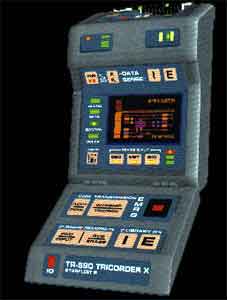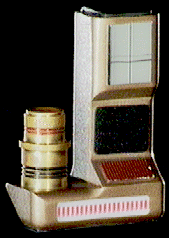ENGINEERING EQUIPMENT
PART 2
ENGINEERING EQUIPMENT
PART 2
Nanopolymer
Densified material that can be used to reinforce components of plasma flow conduits.
ODN Recoupler
Neutrino Probe 
Engineering tool used to scan neutrino readings found in a Starship's warp signature. A standard Starfleet tricorder is not equipped to detect neutrinos.
Engineering tool used in the maintenance of the ODN systems.
ODN
Acronym for Optical data network. A system of fibre-optic data transmission conduits used aboard Federation starships, serving as the nervous system of the ships computer network.
Opti Cable
Fibre optic data transmission cable used aboard Federation starships, as part of the ODN system.
PADD 
In its primary role aboard a starship, the personal access display device (PADD) is a handheld control and display terminal. Small, easily managed terminals and computers are in daily use throughout Starfleet, as a natural response to crew member' needs to (1) execute hardware functions in a variety of locations, and (2)manipulate visual information and communicate that information to others aboard ship. Access to the Starbase computers and other pieces of equipment can be accomplished through the usual control displays and larger terminal screens, of course, but the PADD has become a convenient adjunct to those panels.
The standard small PADD is 10 x 15 x 1 cm and is constructed from three basic layers of imbedded circuit-composite material. All primary electronics, including multilayer display screen, are bonded to the casing, a boronite whisker epoxy. If dropped accidentally, even from a height of 35 m, a PADD will remain undamaged. Replaceable components are limited to three, the sarium power loop, isolinear memory chip, and subspace transceiver assembly (STA).
In normal daily use, the power supply remains installed and is induction recharged. A full charge will last sixteen hours; if a PADD is about to exhaust its battery, it can set a memory flag in the main computer to transfer tasks to a working unit, or suspend them until a later time. The total memory capacity of the isolinear chips is 4.3 kiloquads. Like the tricorder, the PADD can transfer its total memory to the main computers in less than one second if the need arises. The STA issued to maintain data channels between the PADD and the Starbase computers. If taken on an away mission, the PADD can also perform uplink / downlink operations and function as a transporter lock-on node. Data transmissions and computing functions can be shared with any other Starfleet device supporting the STA com protocols. As with the personal communicator, transmissions are encrypted for security purposes.
The display screen, 4.25 times larger than that of a tricorder, allows for the manipulation of control graphics, numerical data, and images by touch. Electrosensitive areas of the casing (coloured brown on the standard engineering PADD) are designed for specific data movement and storage functions. They can also be used to personalise the default set-up and single-crew member security restriction. An audio pickup sensor permits voice input.
The PADD's control functions mimic those of any multilayer panel, insofar as the security restrictions for individual crew members are concerned. Properly configured with the Conn position bridge controls, a crew member can theoretically fly a starship from a PADD while walking down a corridor. While this would be an impractical exercise due to PADD memory limitations and the relatively small display screen, it is an example of the overall multiple-option philosophy established in the design objectives by Starfleet's Research and Design Bureau.
This philosophy treats the starship as an integrated organism in which each component can be regarded as a cell in a body directed by a central brain, but with processing capabilities distributed throughout the neural network. Because of this, PADDs and many other handheld data devices are capable of accessing any data file or command program to which the user has authorised access.
Custom PADD configurations can be fabricated in any starship or starbase hardware replication facility equipped with custom isolinear circuit programming capabilities.
Particle Emitter 
Work tool used aboard Federation Starships and Space Stations.
Pattern Enhancers
Devices used by Starfleet transporter systems to amplify the beam , thereby making personnel transport safer
during relatively hazardous situations.
Phase - Conjugate Graviton Emitter
Engineering device sometimes used in tractor beams to increase lift capacity
Plasma Canister
A device used to transport small amounts of warp plasma.
Plasma Conversion Sensor
Starfleet instrument used to measure the consumption of matter and antimatter fuel during engine use.
Plasma Coolant
Highly corrosive fluid used in warp - drive systems.
Plasma Infuser
Hand Held instrument used for the transfer of high energy plasma.
Plasma Torch 
Work tool used aboard Federation Starships and Space Stations.
Sonic Driver 
Hand held engineering device used to measure tetryon particle flux fields
Standard Tricorder 
The standard tricorder is a portable sensing, computing, and data communications device developed by Starfleet R&D and issued to starship crew members. It incorporates miniaturised versions of those scientific instruments found to be most useful for both shipboard and away missions, and its capabilities may be augmented with mission-specific peripherals. Its many functions may be accessed by touch-sensitive controls or, if necessary, voice command.
MAIN FEATURES
The standard tricorder measures 8.5 x 12 x 3 cm and masses 353 grams. The case is constructed of micro milled duranium foam, and is divided into two hinged sections for compact storage. The control surfaces consist of ruggedized positive-feedback buttons and a 2.4 x 3.6 cm display screen. While a full personal access display device-type multilayer control screen would have afforded the user with a wider range of preferences in organising commands and visual information, the simplified button arrangement was chosen for greater ease of use in the field. The internal electronics, on the other hand, were designed to provide the greatest number of possible options in managing sensor data, visual images, and multichannel communications, in all incoming, outgoing, or recorded modes.
The major electronic components include the primary power loop, sensor assemblies, parallel processing block, control and display interface, subspace communication unit, and multiple memory storage units.
Power is provided to the total system through a rechargeable sarium crystal rated for eighteen hours of full instrument activity. True power usage rate and maximum useful time is, of course, dependent on which subsystems are active, and is continuously computed for call-up on the display. Typical power usage is 15.48 watts. The sensor assemblies incorporate a total of 235 mechanical, electromagnetic, and subspace devices mounted about the internal frame as well as imbedded in the casing material as conferral instruments. One hundred and fifteen of these are clustered in the forward end for directional readings, with a field-of-view (FOV) lower limit of 1/4 degree. The other 120 are omnidirectional devices, taking measurements of the surrounding space. The deployable hand sensor incorporates seventeen high-resolution devices for detailed readings down to an FOV of one minute of arc. Within these FOV limits, both active and passive scans can provide readings approaching the theoretical limits of the EM radiation of physical process under study. By combining readings from different sensors, the tricorder computer processors can synthesise images and numerical readouts to be acted upon by the crew member.
The computer capabilities of the standard tricorder are distributed throughout the device as pre-processors attached to the various sensors and twenty-seven polled main computing segments (PMCS). Each PMCS contains subsections dedicated to rapid management of the sensor assemblies, prioritising of processing tasks, routing of processed data, and management of control and power systems. The PMCS chips supplied with the TR-580 and TR-595H (P) standard tricorders are rated at 150 GFP calculations per second.
The control and display interface (CDI) routes commands from both the panel buttons and display screen to the PMCS for execution of tricorder functions. Multiple functions can be run simultaneously, limited only by PMCS speed. In practice, crew members usually carry out no more than six separate scanning tasks.
Communications functions are carried out by tricorder through the subspace transceiver assembly (STA). Voice and data are uplink / downlinked along standard communicator frequencies. Transmission data rates are variable, with a maximum speed in Emergency Dump Mode of 825 TFP. Communication range is limited to 40,000 km inter-ship, similar to the standard communicator badge.
The data storage sections of the standard tricorder include fourteen wafers of nickel carbonitrium crystal for 0.73 kiloquads of interim processor data storage, and three built-in isolinear optical chips, each with a capacity of 2.06 kiloquads, for a total of 6.91 kiloquads. The swappable library crystal chips are each formatted to hold 4.5 kiloquads. In Emergency Dump Mode, all memory devices are read in sequence and transmitted, including any library chips in place. In practice, the
total time to dump a standard tricorder's memory to a starship/starbase can be as long as 0.875 seconds.
Subspace Field Sensor 
Hand held engineering device
Superconducting Flux Degausser 
Engineering device used throughout Federation Starships inconjuction with Flux generators and Flux spectrometers
Tetryon Analyser 
Engineering tool used to detect cryogenic fuel leaks
DISCLAIMER: Star Trek, The Next Generation, Deep Space Nine, Voyager, and all related elements are the property of Paramount Pictures. No profit is being made off of this page or any of the other pages in this directory. All character names are the property of their respective owners. This site is maintained by Tony Noble: tony_n@bigpond.com